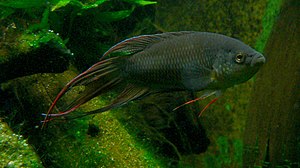Black macro pod
| Black macro pod | ||||||||||||
|---|---|---|---|---|---|---|---|---|---|---|---|---|

Male black macropod ( Macropodus spechti ) |
||||||||||||
| Systematics | ||||||||||||
|
||||||||||||
| Scientific name | ||||||||||||
| Macropodus spechti | ||||||||||||
| Schreitmüller , 1936 |
The black macropod ( Macropodus spechti ) is a freshwater fish species from the suborder of the labyrinth fish . It occurs in Vietnam , probably only in central Vietnam in the area of Huế , possibly also in northwestern Borneo .
features
Male black macropods are a maximum of 12 cm long, females about 7.5 cm long. This makes them a bit slimmer than the other macropod species. The height of the males is about 32.5% of the standard length , females are somewhat higher back with a height of about 37% of the standard length. The forehead line of the black macropod appears concave, while it is more convex in the other macropod species.
The body color of the fish is grayish-yellow, more or less dark, and thus monochrome, in contrast to the other macropod species, which are usually striped, as indicated by the epithet concolor (monochrome) of the synonym . The membranous scale pockets in which the scale bases are located are blackish or dark brown, giving the impression that the scales have a dark edge. This creates a dark grid or net pattern on the fish. Large, dominant males or aggressive females can go completely black during the spawning season. At the age of three months, juvenile fish temporarily show stripes, which later disappear again.
Fin formula : Dorsal X-XII / 8-10, anal XV-XX / 12-15, pectoral 12 (11), ventral I / 5 (I / 4), caudal 15 (14 or 16). Scale formula : mLR 28-29, QR 10 (11-12).
The outer edges of the fins are brick red or bluish white. The elongated caudal rays of old males can be bifurcated up to five times.
Reproduction
Like many other labyrinth fish, black macropods build a foam nest for reproduction . It is built by the male in one day and has a diameter of 15 cm and a height of 1.5 cm. The pair spawns under the nest after a few mock matings. The male first collects the eggs and then inserts them into the nest with an additional layer of foam. This is followed by further mating until the female's egg supply (300 to 400 eggs) is exhausted.
Systematics
The closest relative and sister species of the black macropod is probably the fork-tailed macropod ( Macropodus opercularis ), with which it shares the synapomorphism of the strongly forked caudal fin, while the Chinese or round-tailed macropod ( Macropodus ocellatus ) has a rounded caudal fin. Crossing attempts between the three species also suggest that M. opercularis is more closely related to M. spechti than to M. ocellatus .
Synonyms of M. spechti are: Macropodus concolor Ahl, 1937; Macropodus opercularis concolor Ahl, 1937 and Macropodus opercularis spechti Schreitmüller, 1936. In 2008 Winstanley and Clements synonymous the very similar red-backed macropod ( Macropodus erythropterus ) with Macropodus spechti , which was first described in 2002 .
literature
- Hans-Joachim Paepke: The paradise fish: genus Macropodus. In: The New Brehm Library. Volume 616. Westarp Sciences, Magdeburg 1994, ISBN 3-89432-406-6 .
- Winstanley, T. & KD Clements (2008): Morphological re-examination and taxonomy of the genus Macropodus (Perciformes: Osphromenidae) . Zootaxa (1908): pp. 1-27.
Individual evidence
Web links
- Black Macropod on Fishbase.org (English)
- Macropodus spechti inthe IUCN 2013 Red List of Threatened Species . Posted by: Huckstorf, V., 2010. Retrieved December 10, 2013.